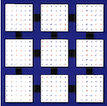1 SUBROUTINE zdbtf2( M, N, KL, KU, AB, LDAB, INFO )
14 INTEGER INFO, KL, KU, LDAB, M, N
17 COMPLEX*16 AB( LDAB, * )
88 DOUBLE PRECISION ONE, ZERO
89 parameter( one = 1.0d+0 )
90 parameter( zero = 0.0d+0 )
91 COMPLEX*16 CONE, CZERO
92 parameter( cone = ( 1.0d+0, 0.0d+0 ) )
93 parameter( czero = ( 0.0d+0, 0.0d+0 ) )
96 INTEGER J, JP, JU, KM, KV
103 EXTERNAL zgeru, zscal, zswap
136 IF( m.EQ.0 .OR. n.EQ.0 )
146 DO 40 j = 1,
min( m, n )
153 IF( ab( kv+1, j ).NE.zero )
THEN
154 ju =
max( ju,
min( j+ku, n ) )
160 CALL zscal( km, one / ab( ku+1, j ), ab( ku+2, j ), 1 )
165 CALL zgeru( km, ju-j, -cone, ab( ku+2, j ), 1,
166 $ ab( ku, j+1 ), ldab-1, ab( ku+1, j+1 ),

